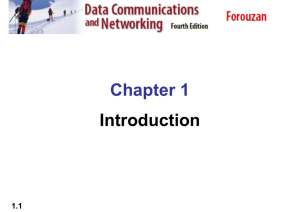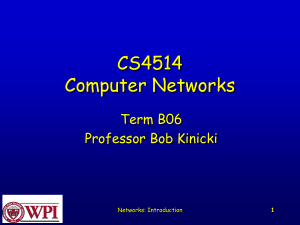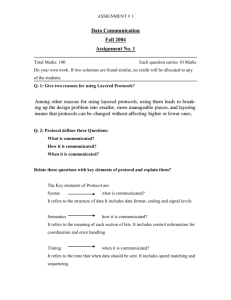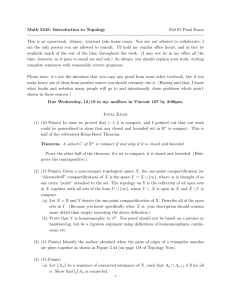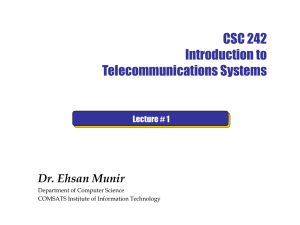Chap 1
advertisement
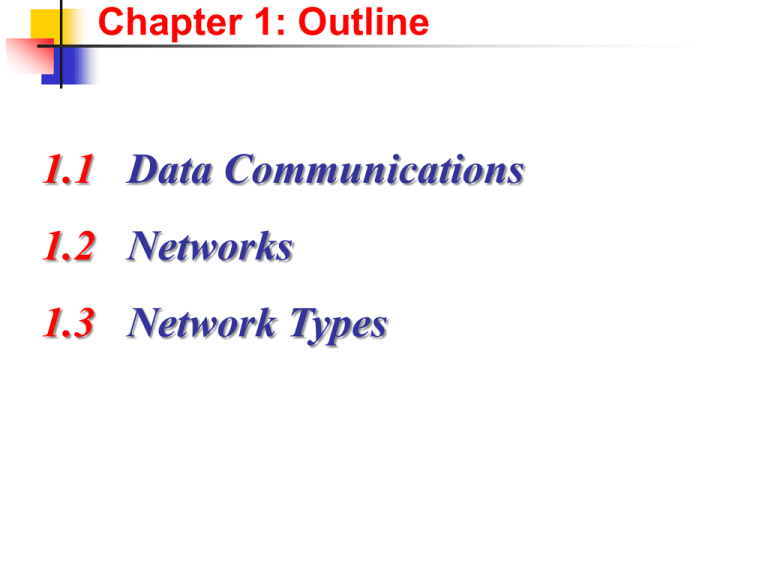
Chapter 1: Outline 1.1 Data Communications 1.2 Networks 1.3 Network Types 1-1 DATA COMMUNICATIONS When we communicate, we are sharing information. 1.2 1-1 DATA COMMUNICATIONS The term telecommunication, which includes telephony, telegraph, and television, means communication at a distance. 1.3 1-1 DATA COMMUNICATIONS Data communications are the exchange of data between two devices via some form of transmission media. 1.4 1.1.1 Components A data communications system has five components (see Figure 1.1). 1.5 1.1.1 Components A data communications system has five components (see Figure 1.1). Sender 1.6 1.1.1 Components A data communications system has five components (see Figure 1.1). Sender Receiver 1.7 1.1.1 Components A data communications system has five components (see Figure 1.1). Sender Receiver Message 1.8 1.1.1 Components A data communications system has five components (see Figure 1.1). Sender Receiver Message Transmission medium 1.9 1.1.1 Components A data communications system has five components (see Figure 1.1). Sender Receiver Message Transmission medium Protocol 1.10 Figure 1.1: Five components of data communication 1.11 1.1.2 Data Representation Information today comes in different forms such as text, numbers, images, audio, and video. 1.12 1.1.3 Data Flow Communication between two devices can be simplex 1.13 1.1.3 Data Flow Communication between two devices can be simplex, half-duplex 1.14 1.1.3 Data Flow Communication between two devices can be simplex, half-duplex, or full-duplex 1.15 Figure 1.2: Data flow 1.16 1-2 NETWORKS A network is the interconnection of a set of devices capable of communication. 1.17 1.2.1 Network Criteria According to Forouzan: A network must be able to meet a certain number of criteria. The most important of these are performance, reliability, and security. 1.18 CIA Confidentiality (security) Integrity (reliability) Availability (performance) McGraw-Hill 1.19 ©The McGraw-Hill Companies, Inc., 2000 1.2.2 Physical Structures Before discussing networks, we need to define some network attributes. 1.20 1-2 Vacabulary • • • 1.21 node - host, network hardware device, printer, server, etc link - aka segment or edge scalability – the relative ease in changing nodes and links of a network. Figure 1.3: Types of connection 1.22 Figure 1.6: A bus topology 1.23 1-2 Bus Topology • Simple to wire. • Difficult to diagnose problems • Low fault tolerance • not scalable due to the shared backbone 1.24 Figure 1.7: A ring topology 1.25 1-2 Ring Topology • Simple to wire. • Requires special repeater hardware • Not as popular as it once was 1.26 Figure 1.5: A star topology 1.27 1-2 Star Topology • Simple to wire. • Scalable to large networks • Easy to diagnose problems • Requires more wire • Single point of failure 1.28 Figure 1.4: A fully-connected mesh topology 1.29 1-2 Mesh Topology • Easy to diagnose problems • High fault tolerance •Complex to wire. • Requires more wire 1.30 Figure 1.12: compound topology 1.31 1-3 NETWORKS TYPES: LANs & WANs The criteria of distinguishing one type of network from another is difficult and sometimes confusing. We use a few criteria such as size, geographical coverage, and ownership to make this distinction. 1.32 1.3.1 Local Area Network A domain within a well defined address space. A LAN is usually characterized as having a single owner 1.33 Figure 1.8: An Isolated LAN in the past and today 1.34 1.3.2 Wide Area Network Two or more LANs connected together to form a larger more capable network. 1.35 Figure 1.9: A Point-to-Point WAN 1.36 Figure 1.11: An internetwork made of two LANs and one WAN 1.37 Figure 1.10: A Switched WAN 1.38 Figure 1.12: A heterogeneous network made of WANs and LANs 1.39 1.3.3 Switching (circuit vs packet) The two most common types of switched networks are circuit-switched and packet-switched networks. We discuss both next. 1.40 Figure 1.13: A circuit-switched network 1.41 Figure 1.14: A packet-switched network 1.42 1.3.4 The Internet An internet (note the lowercase i) is two or more networks that can communicate with each other. The most notable internet is called THE Internet (uppercase I), and is composed of thousands of interconnected networks all over the world. 1.43 Figure 1.15: The Internet today 1.44





